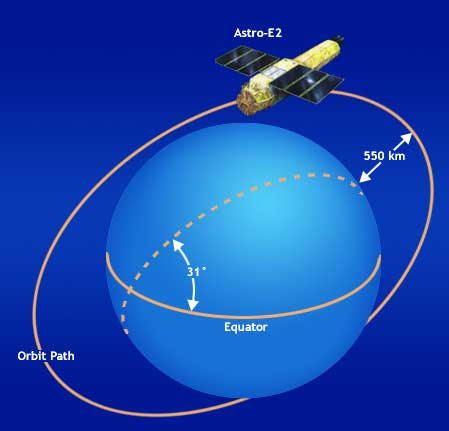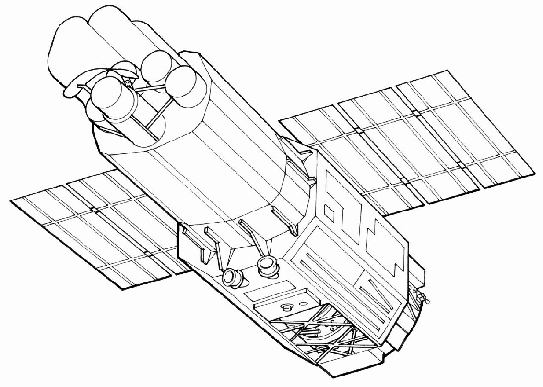
|
This chapter is a brief introduction to the satellite and its instruments and is intended as a simplified guide for the proposer. Reading it thoroughly should provide the reader with the necessary information to understand the capabilities of the instruments at a level sufficient to prepare the feasibility section of a Suzaku proposal.
To date Suzaku has accumulated extensive data from calibration, SWG and
GO observations. The list of all observations performed is available
in the Browse master catalog at the High Energy Astrophysics Science
Archive Research Center (HEASARC) at http://heasarc.gsfc.nasa.gov/cgi-bin/W3Browse/w3browse.pl
and at
http://heasarc.gsfc.nasa.gov/docs/suzaku/docs/suzaku/aehp_time_miss.html.
Suzaku is in many ways similar to ASCA in terms of orbit, pointing, and
tracking capabilities. Suzaku uses the same station (USC) as ASCA did
for up-link and down-link, although down-link at NASA DSN is not possible
with Suzaku (see footnote in subsection 3.2.1). As a
result, the operational constraints for Suzaku are also similar to those
of ASCA. Suzaku is placed in a near-circular orbit with an apogee of
568km, an inclination of 31.9degrees, and an orbital period of
about 96minutes. The maximum slew rate of the spacecraft is
![]() degrees/min, and settling to the final attitude takes
degrees/min, and settling to the final attitude takes ![]() minutes, using the star trackers. The normal mode of operations
will have the spacecraft pointing in a single direction for at least
1/4day (10ks net exposure time). With this constraint, most
targets will be occulted by the Earth for about one third of each
orbit, but some objects near the orbital poles can be observed nearly
continuously. The observing efficiency of the satellite as measured
after four years of operation is about 45%.
minutes, using the star trackers. The normal mode of operations
will have the spacecraft pointing in a single direction for at least
1/4day (10ks net exposure time). With this constraint, most
targets will be occulted by the Earth for about one third of each
orbit, but some objects near the orbital poles can be observed nearly
continuously. The observing efficiency of the satellite as measured
after four years of operation is about 45%.


|
The scientific payload of Suzaku (Fig. 3.2) initially consisted of three distinct co-aligned scientific instruments. There are four X-ray sensitive imaging CCD cameras (X-ray Imaging Spectrometers, or XISs), three front-illuminated (FI; energy range 0.4-12keV) and one back-illuminated (BI; energy range 0.2-12keV), capable of moderate energy resolution. Each XIS is located in the focal plane of a dedicated X-ray telescope. The second instrument is the non-imaging, collimated Hard X-ray Detector (HXD), which extends the bandpass of the observatory to much higher energies with its 10-600keV pointed bandpass. The X-Ray Spectrometer (XRS) is no longer operational, and will not be discussed further. Interested readers are invited to access the XRS instrument paper at http://www.astro.isas.jaxa.jp/suzaku/doc/suzakumemo/suzakumemo-2006-38.pdf.

|
All of the instruments on Suzaku operate simultaneously. Each of the
co-aligned XRTs features an X-ray mirror with an angular resolution
(expressed as Half-Power Diameter, or HPD) of ![]() (Fig. 3.4). Figure 3.3 shows the total
effective area of the XIS+XRT, which includes features due to the
elemental composition of the XIS and XRT. K-shell absorption edges
from oxygen (0.54keV) and aluminum (1.56keV) in the blocking
filters are present, as well as a number of weak M-shell features
between 2-3keV arising from the gold in the XRT.
(Fig. 3.4). Figure 3.3 shows the total
effective area of the XIS+XRT, which includes features due to the
elemental composition of the XIS and XRT. K-shell absorption edges
from oxygen (0.54keV) and aluminum (1.56keV) in the blocking
filters are present, as well as a number of weak M-shell features
between 2-3keV arising from the gold in the XRT.
The four XISs (Fig. 7.3) are true imagers, with a large
field of view (
![]() ), and moderate spectral
resolution.
), and moderate spectral
resolution.

|
The HXD (Fig. 8.1) is a non-imaging instrument with an
effective area of ![]() 260cm
260cm![]() , featuring a compound-eye
configuration and an extremely low background. It dramatically extends
the bandpass of the mission with its nominal sensitivity over the
10-600keV band (Fig. 3.5). The HXD consists of two
types of sensors: 2mm thick silicon PIN diodes sensitive over
10-70keV, and GSO crystal scintillators placed behind the PIN
diodes covering 40-600keV. The HXD field of view is actively
collimated to 4.5
, featuring a compound-eye
configuration and an extremely low background. It dramatically extends
the bandpass of the mission with its nominal sensitivity over the
10-600keV band (Fig. 3.5). The HXD consists of two
types of sensors: 2mm thick silicon PIN diodes sensitive over
10-70keV, and GSO crystal scintillators placed behind the PIN
diodes covering 40-600keV. The HXD field of view is actively
collimated to 4.5![]() 4.5
4.5![]() by the well-shaped BGO
scintillators, which, in combination with the GSO scintillators, are
arranged in the so-called phoswich configuration. At energies below
by the well-shaped BGO
scintillators, which, in combination with the GSO scintillators, are
arranged in the so-called phoswich configuration. At energies below
![]() 100keV, an additional passive collimation further reduces the
field of view to 34
100keV, an additional passive collimation further reduces the
field of view to 34![]() 34
34![]() . The energy resolution is
. The energy resolution is
![]() 4.0keV (FWHM) for the PIN diodes, and 7.6 /
4.0keV (FWHM) for the PIN diodes, and 7.6 / ![]() %
(FWHM) for the scintillators (where
%
(FWHM) for the scintillators (where ![]() is energy in MeV). The HXD
time resolution for both sensors is 61
is energy in MeV). The HXD
time resolution for both sensors is 61![]() s. While the HXD is
intended mainly to explore the faintest hard X-ray sources, it can
also tolerate very bright sources up to
s. While the HXD is
intended mainly to explore the faintest hard X-ray sources, it can
also tolerate very bright sources up to ![]() 10Crab. The HXD also
performs as an all-sky monitor (the Wide-band All-sky Monitor (WAM),
which can detect GRBs and other sources. Although observers will
receive data from the WAM, it cannot be proposed for directly and has
special rules regarding data rights; see Chapter 4.
10Crab. The HXD also
performs as an all-sky monitor (the Wide-band All-sky Monitor (WAM),
which can detect GRBs and other sources. Although observers will
receive data from the WAM, it cannot be proposed for directly and has
special rules regarding data rights; see Chapter 4.
Because the HXD bore-sight axis, with the highest effective area, is
about 3.5arcmin shifted from that of the XISs, the Suzaku operations
team supported two aim points, XIS and HXD oriented, in the past. The
XIS aim point provides a ![]() 10
10![]() larger XIS effective area than
the HXD aim point. Conversely for the HXD, the HXD aim point provides
a
larger XIS effective area than
the HXD aim point. Conversely for the HXD, the HXD aim point provides
a ![]() 10
10![]() larger HXD effective area than the XIS aim point. A
10% increase in effective area corresponds to a 10% and 20%
increase in observing time for source and background dominated
observations, respectively. In order to mitigate effects due to the
increased attitude jitter of Suzaku since the end of 2009 the HXD aim
point is not supported anymore in AO-7.
larger HXD effective area than the XIS aim point. A
10% increase in effective area corresponds to a 10% and 20%
increase in observing time for source and background dominated
observations, respectively. In order to mitigate effects due to the
increased attitude jitter of Suzaku since the end of 2009 the HXD aim
point is not supported anymore in AO-7.
Suzaku carries a 6Gbit data recorder. Data will be down-linked to USC at a rate of 4Mbps for a total of 2Gbits per pass, up to 5 times a day. This allows a maximum of 10Gbits of data to be obtained per day, but fewer passes may be available to Suzaku as it will share the use of USC ground station with other ISAS satellites3.1. Data can be recorded at 4 different rates: Super-High (524kbps), High (262kbps), Medium (131kbps), and Low (33kbps). The recording rate will be changed frequently throughout an observation, according to a sequence that will be determined by the operations team at ISAS. This is to optimize the selection of the data rates and the usage of the data recorder, taking into account the expected count rates supplied by the proposers. Thus an accurate estimation of the count rates is important for the optimization of the mission operation. We emphasize that proposers cannot arbitrarily choose the data recording rate.
On-source data will usually be recorded at High (during contact orbits, during which the satellite passes over USC) or Medium (during remote orbits, without USC passes) data rate. The Low rate will primarily be used for times of Earth occultations and SAA passages, as the background rates in the XIS and HXD exceed their telemetry allocation limit at Low data rate. The telemetry limits for the XIS are presented in Chapter 7. The XIS data mode will be chosen for each data recording rate used to prevent telemetry saturation, based on the count rate supplied by the proposer.
Suzaku excels for observations such as:
Suzaku is less appropriate for:
Table 3.2 summarizes the calibration items of all scientific instruments, the current status, and their expected and measured accuracy.
These values are the 90% limits, equivalent to 1.6![]() . Note
that the values listed are those required from the scientific purpose
and ultimate goals which are possible to be realized on the basis of
the instrument design.
. Note
that the values listed are those required from the scientific purpose
and ultimate goals which are possible to be realized on the basis of
the instrument design.
| Calibration Item | Oct 2008 | Requirement | Goal | |
|
XRT |
On-axis effective area |
|
5% | 5% |
| Vignetting |
|
5% | 2% | |
| On-axis EEF |
|
5% | 1% | |
| Off-axis EEF |
|
20% | 2% | |
| Optical axis position in XIS | |
|
|
|
| Energy scale |
max(0.2%, 5eV) | 0.1% | 0.1% | |
| Energy resolution (FWHM) at 5.9keV | 5% |
1% | 1% | |
| Contamination thickness |
10 |
N/A | N/A | |
| OBF integrity | unbroken | broken/unbroken | broken/unbroken | |
| HXD | Absolute effective area | 20% | 20% | 5% |
| Relative effective area | 10% | 10% | 5% | |
| Vignetting | 5% | 10% | 5% | |
| Background modeling (PIN) |
|
10% | 1% | |
| Background modeling (GSO) |
|
10% | 3% | |
| Absolute timing |
300 |
300 |
100 |
|
| Relative timing |
1.9 |
10 |
10 |
|
| GRB absolute timing | |
10ms | 1ms |
|
a: Valid in the 2-10 keVband. Calibration uncertainty may become
larger outside this energy range, especially below 0.3keV (BI chip)
and above 10keV. We calibrated the effective area using spectral
parameters of the Crab emission as those given by Toor & Seward
(1974, AJ, 79, 995).
b: For all integration radii from 1 c: As on-axis but for all XIS f.o.v. No calibration is currently scheduled. d: For the normal mode data. Uncertainties of the energy scale increase when the Burst and/or Window options are applied. e: When xisrmfgen is used. Note that an error of 5% in the energy resolution could produce an artificial line width of as large as f: Uncertainty represented as the carbon-equivalent column density. Valid only at the center of the field of view. g: Modeling accuracy depends on energy-band and exposure. See Chapter 8.5 for typical examples. h: The Crab and PSR B1509-58 pulses are clearly detected in the quick look analysis of calibration data.
|